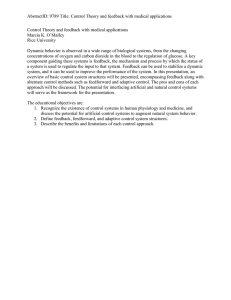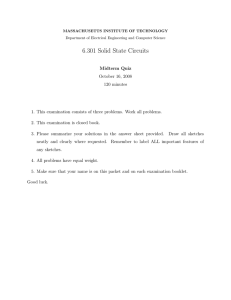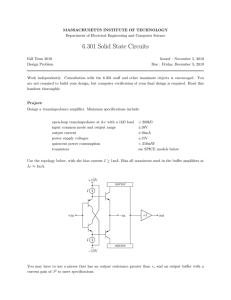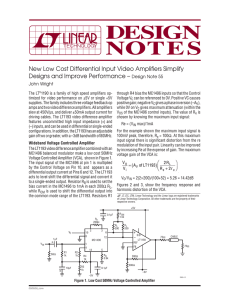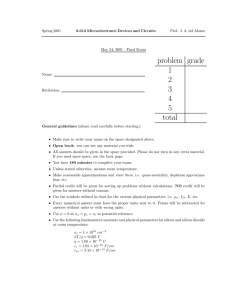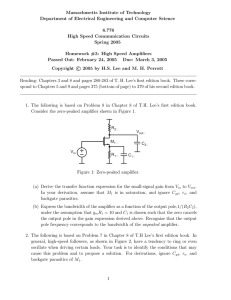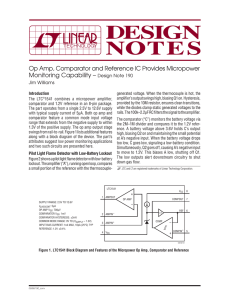An Adaptive Feedforward Amplifier Application for 5.8 GHz
advertisement
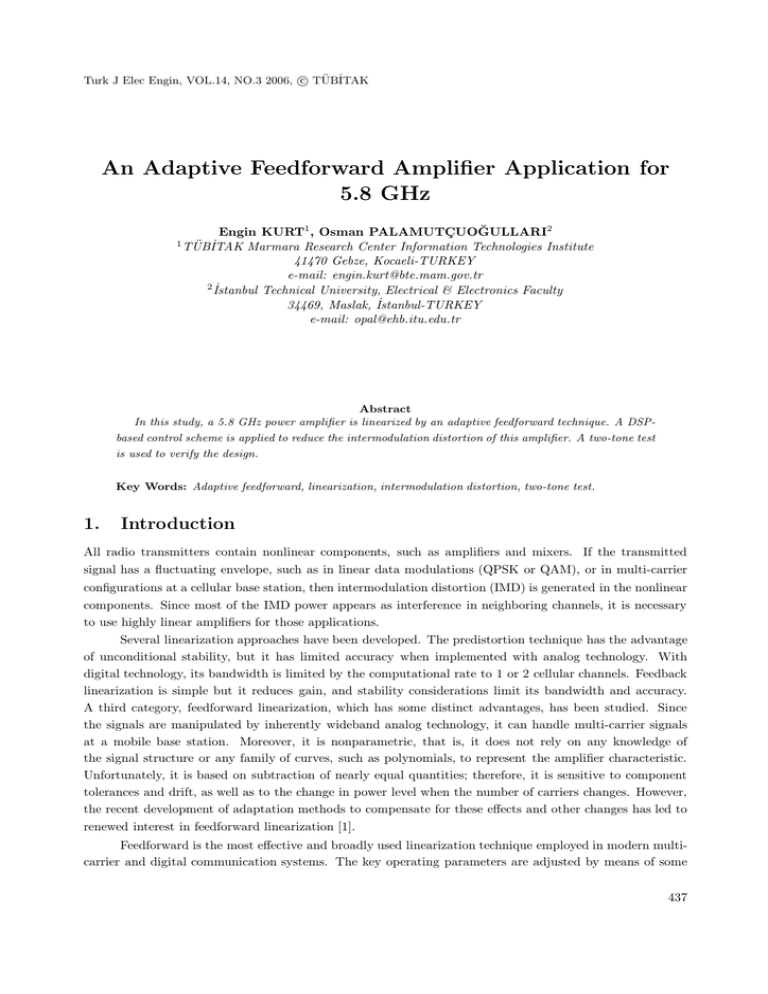
c TÜBİTAK Turk J Elec Engin, VOL.14, NO.3 2006, An Adaptive Feedforward Amplifier Application for 5.8 GHz 1 Engin KURT1 , Osman PALAMUTÇUOĞULLARI2 TÜBİTAK Marmara Research Center Information Technologies Institute 41470 Gebze, Kocaeli-TURKEY e-mail: engin.kurt@bte.mam.gov.tr 2 İstanbul Technical University, Electrical & Electronics Faculty 34469, Maslak, İstanbul-TURKEY e-mail: opal@ehb.itu.edu.tr Abstract In this study, a 5.8 GHz power amplifier is linearized by an adaptive feedforward technique. A DSPbased control scheme is applied to reduce the intermodulation distortion of this amplifier. A two-tone test is used to verify the design. Key Words: Adaptive feedforward, linearization, intermodulation distortion, two-tone test. 1. Introduction All radio transmitters contain nonlinear components, such as amplifiers and mixers. If the transmitted signal has a fluctuating envelope, such as in linear data modulations (QPSK or QAM), or in multi-carrier configurations at a cellular base station, then intermodulation distortion (IMD) is generated in the nonlinear components. Since most of the IMD power appears as interference in neighboring channels, it is necessary to use highly linear amplifiers for those applications. Several linearization approaches have been developed. The predistortion technique has the advantage of unconditional stability, but it has limited accuracy when implemented with analog technology. With digital technology, its bandwidth is limited by the computational rate to 1 or 2 cellular channels. Feedback linearization is simple but it reduces gain, and stability considerations limit its bandwidth and accuracy. A third category, feedforward linearization, which has some distinct advantages, has been studied. Since the signals are manipulated by inherently wideband analog technology, it can handle multi-carrier signals at a mobile base station. Moreover, it is nonparametric, that is, it does not rely on any knowledge of the signal structure or any family of curves, such as polynomials, to represent the amplifier characteristic. Unfortunately, it is based on subtraction of nearly equal quantities; therefore, it is sensitive to component tolerances and drift, as well as to the change in power level when the number of carriers changes. However, the recent development of adaptation methods to compensate for these effects and other changes has led to renewed interest in feedforward linearization [1]. Feedforward is the most effective and broadly used linearization technique employed in modern multicarrier and digital communication systems. The key operating parameters are adjusted by means of some 437 Turk J Elec Engin, VOL.14, NO.3, 2006 mechanism of automatic adaptation. The key aspects of the feedforward linearization technique are the amplitude and phase imbalances, as well as the inequality of the signal delays among the different branches that are compared [2]. In this study, a brief description of typical feedforward architecture is made and the simulation results of an adaptation technique for these imbalances, which are found by using the least mean square (LMS) algorithm, are provided. The simulation was done entirely in Agilent’s ADS simulation tool and the results are presented. 2. Feedforward Technique The architecture of the well-known feedforward linearizer has the form as illustrated in Figure 1. Since the power amplifier (PA) presents amplitude and phase distortion, it will be assumed that its output is made up of an amplified version of the input signal plus certain intermodulation (IMD) products. A feedforward amplifier achieves its linearity improvement by canceling the intermodulation products produced by the main amplifier. A signal composed of only the distortion produced by the main amplifier is generated by the carrier cancellation loop. The error signal is adjusted to be equal in amplitude, but 180 ◦ out of phase with the IMD products of the main amplifier. By adding the error signal of the main amplifier, IMD cancellation is achieved. Ideally, the linearization technique of the amplifier aims to completely eliminate the distortion present in the PA output signal. Main Amplifier (PA) Va fc fc Vin Input Main Signal Cancellation Loop Vo fc Output τ Error Signal Cancellation Loop 1 k 1 τ 1 k 2 Veo Vei fc fc Figure 1. General architecture of a feedforward amplifier. A feedforward amplifier consists of 2 loops. The first loop is a carrier cancellation loop and obtains the IMD products of the main amplifier (denoted as the error signal). The second loop is the IMD cancellation loop, which is used to reduce the output IMD products with the error signal. The amount of correction is limited by the ability of the 2 loops to match gain and phase between the main signal and error paths. 3. Mathematical Representation For simulation purposes, the equivalent adaptive feedforward amplifier model is shown in Figure 2. The PA and the error amplifier are represented by the complex gains, G and g, respectively. While G is a function of the input signal amplitude, g is assumed to be constant, which implies a linear operation of the error amplifier. The same power amplifier can be in both loops. For the first loop, it is used as a power amplifier because of high power operations. On the other hand, since the second loop operates at much lower power 438 KURT, PALAMUTÇUOĞULLARI: An Adaptive Feedforward Amplifier Application for 5.8 GHZ, levels, it is used as a linear error amplifier in this loop. The terms (1/k 1 ) and (1/k 2 ) represent the coupling factors of the directional couplers used in the signal cancellation circuit and the error cancellation circuit, respectively. The complex quantities a and b constitute adjustable parameters for the compensation of the gain and phase imbalances among the branches that are compared. Main Amplifier (PA) Va Vo τ (G) Output Vin Input Main Signal Cancellation Loop τ Error Signal Cancellation Loop 1 k1 Vei a b (g) 1 k2 Veo Error Amplifier Vin DSP-based control circuit Vei Vei DSP-based control circuit Vo Figure 2. Adaptive feedforward amplifier model. Input signal can be assumed as Vin = cjφ(t) (1) As previously mentioned, the nonlinear PA introduces amplitude and phase distortion. The PA output is Va = G1 Vin + vIM D (2) G1 = |G1 | ejα : The linear gain of PA G1 vin : Amplified version of the input signal plus a certain phase shift, α vIM D : Intermodulation products In the signal cancellation circuit, a fraction of the PA output signal v a /k 1 , with k 1 real, is compared with a sample of the input av in , with a complex, resulting in an error signal v ei given by vei = G1 1 vin + vIM D − avin k1 k1 (3) If a is adjusted in such a way that a= G1 k1 (4) the error signal v ei will contain only the intermodulation products. vei = 1 vIM D k1 (5) In order to adjust these gain and phase imbalances accurately, the complex parameter, a, will be altered by means of an adaptive procedure. In a similar way, in the error canceling circuit, the error signal is amplified in a second (error) amplifier to obtain veo = gvei (6) 439 Turk J Elec Engin, VOL.14, NO.3, 2006 where g = |g| ejβ is the gain of the second amplifier. In a way similar to the previous case, the gain and phase of the signal v a will be adjusted by means of the complex parameter, b , before comparing it to the signal v o , which is free of distortions vo = Va − veo k2 (7) where k 2 is a real parameter. Using (2), (3), and (6) in (7), the output voltage can be formed as follows: vo = G1 vin + vIM D − b g vIM D k1 k2 (8) If b is adjusted such that b= k1 k2 g (9) the equation for v o becomes vo = Gvin (10) which is simply equal to the linear gain of the power amplifier. The complex parameter b will be adjusted by means of an adaptive algorithm similar to the one used with the parameter a. 4. Adaptive Solution An effective solution for an adaptive estimate of the complex parameters a and b includes the use of digital signal processing (DSP) in both cancellation circuits. The complex parameters a and b will be adjusted according to the LMS (Least Mean Square) algorithm implemented in the numerical domain (help of Agilent ADS simulator). Only the equations corresponding to the adaptation of parameter a are developed with the assumption that the same ones are completely applicable to parameter b . According to the LMS algorithm, the equations for a are given by ∗ (n) a (n) = a (n − 1) + ∆ · vin (n) · vei (11) ∗ a (n) − a (n − 1) = K · ∆τ · vin (n) · vei (n) (12) where K: constant of adaptation that fixes the algorithm adaptation speed V in : PA input signal ∗ vei : complex conjugate of the error signal described by (3). Equation (12) can take the equivalent form a (n) − a (n − 1) ∗ (n) = K · vin (n) · vei ∆τ (13) Taking the limit for ∆τ approaching zero and assuming a(τ ) to be analytic, da ∗ (τ ) = K · vin (τ ) · vei dτ 440 (14) KURT, PALAMUTÇUOĞULLARI: An Adaptive Feedforward Amplifier Application for 5.8 GHZ, and the actual expression for a is obtained as t ∗ vin (τ ) · vei (τ ) dτ a (t) = K (15) 0 Equation (15) can be simulated easily using the DSP-based Agilent Ptolemy simulator of Agilent’s ADS. 5. Simulation Results A Toshiba Microwave Semiconductor TMD0507-2A Microwave MMIC Amplifier is used for the simulation. The amplifier typically supplies 25 dB gain and offers +33 dBm P1dB, and 22.0dB G1dB. Nonlinear S parameters of the amplifier are used in the simulation. In Figure 3, the delay characteristic of TMD0507-2A is shown. Delay elements are used in both loops to compensate for this delay. A complex correlator is used to simulate equation (15) in the DSP controller unit. A simulation model is used, which is constructed by using Agilent’s ADS DSP blocks for the complex correlator. The basic correlator unit has 2 inputs and outputs. For the first loop, inputs are the main and error signals to be correlated; for the second loop, inputs are the error and feedforward output signals to be correlated. The outputs of the correlators are adaptation coefficients, alpha and beta. These adaptation coefficients are applied directly to the complex gain adjusters of both loops, which are used for adjusting gain and phase to match both the upper and lower branches. In Figures 4 and 5, adaptation coefficients alpha and beta are shown with respect to time. Group Delay 1.04n Group Delay 1.02n 1.00n 980.p 960.p 940.p 5.00G 5.95G 5.90G 5.85G 5.80G 5.75G 5.70G 5.65G 5.60G 920.p Freq (Hz) Figure 3. Delay characteristic of the amplifier used. Alpha 0.80 Alpha_Q,V Alpha_I,V Real 0.60 0.40 Imaginary 0.20 0.00 -0.20 0 2 4 6 Time (µs) 8 10 12 Figure 4. Adaptation coefficient alpha. 441 Turk J Elec Engin, VOL.14, NO.3, 2006 Beta 0.40 Real Beta_Q,V Beta_I,V 0.30 0.20 0.10 0.00 Imaginary -0.10 -0.20 0 50 100 150 200 Time (µs) 250 300 350 Figure 5. Adaptation coefficient beta. When a two-tone signal is applied to the input of the amplifier, the output is Figure 6. In the figure, the third order IMD is about –30 dBc. Power Amplifier Output dBm (Power_Amp_Output) 40 30 20 10 0 -10 -20 -30 -40 -50 -60 -70 -80 -90 -100 -110 -120 5.70 5.72 5.74 5.76 5.78 5.80 5.82 Freq (GHz) 5.84 5.86 5.88 5.90 Figure 6. Power amplifier output. In Figures 7 and 8, signal cancellation output (error signal) and feedforward output are shown, respectively. It is clearly seen that the third order IMD is about –55 dBc and that 25 dB improvement is achieved in the IMD performance of the amplifier. dBm(Error_Spectrum_Final) Error Spectrum 40 30 20 10 0 -10 -20 -30 -40 -50 -60 -70 -80 -90 -100 -110 -120 5.70 5.72 5.74 5.76 5.78 5.80 5.82 5.84 5.86 5.88 5.90 Freq (GHz) 442 KURT, PALAMUTÇUOĞULLARI: An Adaptive Feedforward Amplifier Application for 5.8 GHZ, Figure 7. Error signal (signal cancellation output). dBm (FF_Output_Final) Feedforward Output 40 30 20 10 0 -10 -20 -30 -40 -50 -60 -70 -80 -90 -100 -110 -120 5.70 5.72 5.74 5.76 5.78 5.80 5.82 Freq (GHz) 5.84 5.86 5.88 5.90 Figure 8. Feedforward output. 6. Conclusions An adaptive feedforward amplifier with high linearization performance for multi-carrier applications has been designed using a simulation made with EDA tools. An acceptable estimate of the complex parameters a and b for the amplitude and phase imbalance compensation in the signal cancellation circuit and the error cancellation circuit, respectively, of a feedforward linearizer was possible using digital processing of the corresponding signals. A basic adaptive structure based on the LMS algorithm was analyzed and simulated. When compared with the literature, feedforward gives faster and much more accurate results. It can compress up to 40 dB of the IMD term in practical application. When used with DSP technology, it achieves very fast converging speed for the error correction and this gives extra performance in communication systems. References [1] James K. Cavers, “Adaptation Behavior of a Feedforward Amplifier Linearizer”, IEEE Transactions on Vehicular Technology, Vol. 44, No. 1, February 1995 [2] Alfonso J. Zozaya, Eduard Bertran Alberti, Jordi Berenguer-Sau, Adaptive Feedforward Amplifier Linearizer Using Analog Circuitry, Microwave Journal, Vol. 4, pp. 102-114, July 2001 [3] Jianyi Zhou, Limin Feng, Xiaowei Zhu, Wei Hong, Design of an Ultralinear Wideband Feedforward Amplifier Using EDA Tools, Microwave Journal, Vol. 43, January 2000 443
